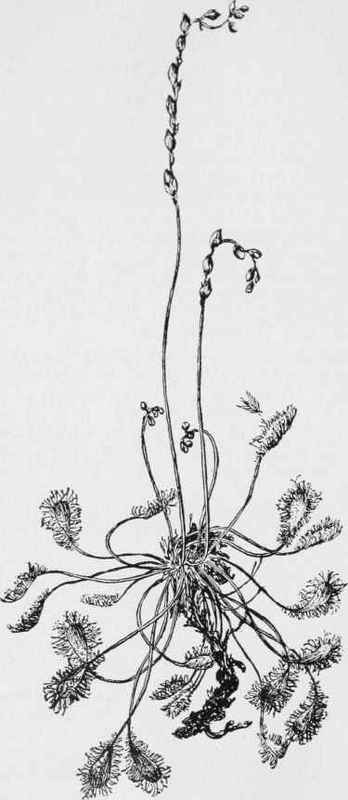Round-leaved Sundew. Drosera Rotundifblia
Description
This section is from the book "Harper's Guide To Wild Flowers", by Caroline A. Creevey. Also available from Amazon: Harper's Guide To Wild Flowers.
Round-leaved Sundew. Drosera Rotundifblia
Family, Sundew. Petals, sepals, stamens, 5, or sometimes 6. Styles, 3 to 5, so deeply divided as to seem twice the number. Leaves, clustered at the root, round or oblong, on long stems, glandular, hairy. June to August.

Round-leaved sundew (Drosera rotundifolia)
Flowers are borne on prolonged leafless stems, on one side. They open only in sunshine, and must be pressed for the herbarium as soon as gathered. The curious leaves resemble in shape a long-handled frying-pan. They are covered with reddish hairs tipped with purple glands.
Our pretty, be jeweled bog-herb is carnivorous. It craves animal food, and employs wily means for obtaining it. An insect alighting upon the open leaves instantly arouses the glands to activity, as food in the stomach excites the gastric juices. Red tentacles close upon and hold fast the prisoner, pouring the contents of the glands upon it, and the process of digestion and absorption begins at once. Only very small insects can thus be entrapped, because of the smallness of the leaves.
A cranberry marsh near my summer cottage on Long Island is almost carpeted with this sundew, so as to give it a reddish hue. The young leaves are rolled up, like ferns, from apex to base. (See illustration, p. 82.)
Long-leaved Sundew D. longifolia,. - This differs from the last, mainly in the shape of its leaves, which are spatulate, long, rather than round. Also the glandular hairs are not found on the leaf-stalks. It is rarer than the last, low, 3 to 8 inches high. June to August.
In bogs, or even in water. I have found it only in wet woods in New Jersey.
Continue to:


